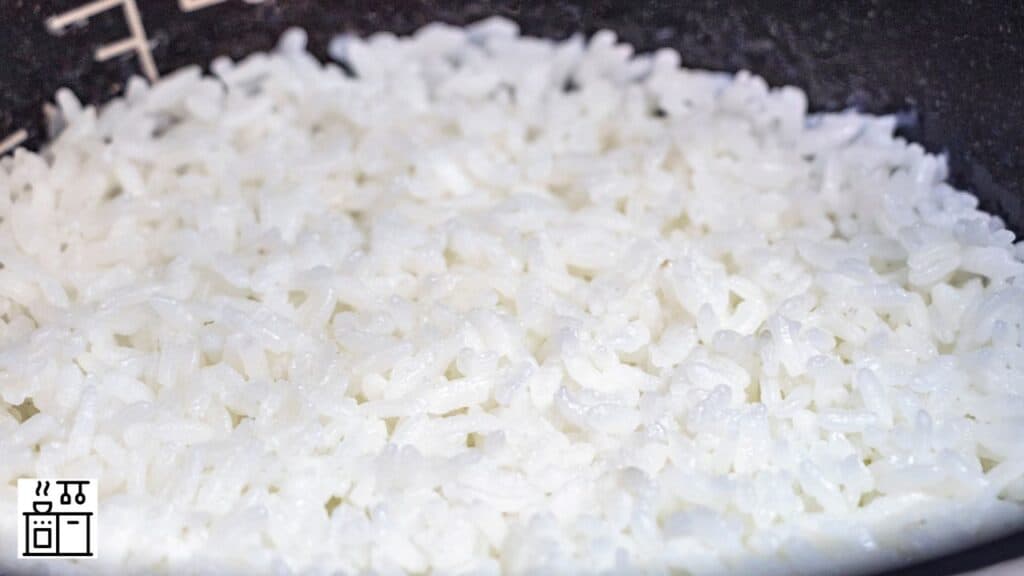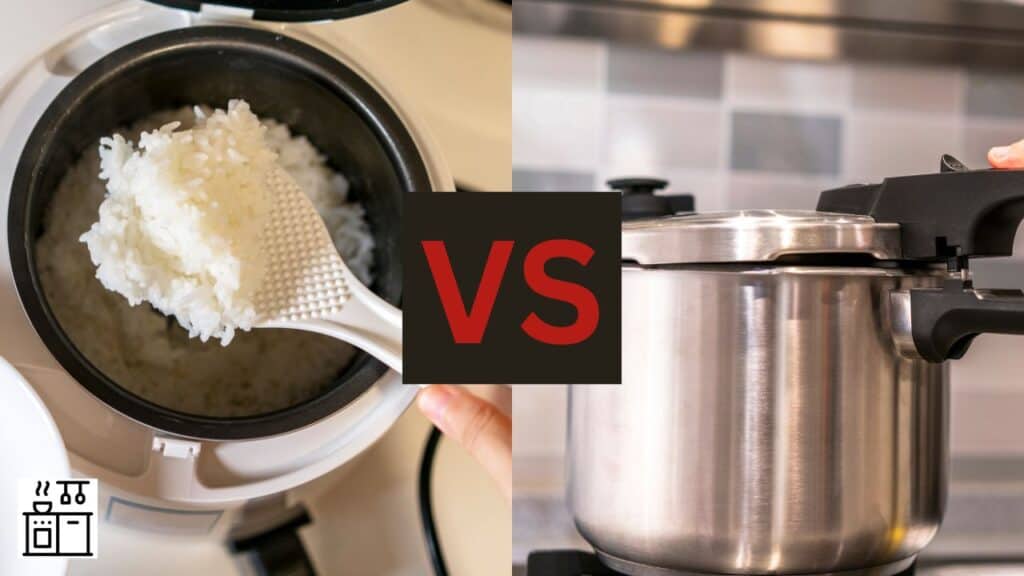Rice cookers and pressure cookers are essential kitchen appliances that simplify cooking.
Although they have a lot of similarities, they are very distinct.
Here are the differences between rice cookers and pressure cookers.
1. Method of Cooking
One of the most significant differences between a rice cooker and a pressure cooker is the method of cooking.
A rice cooker is a self-contained unit with a cooking pot placed inside a casing.
There is an electric heating element at the base of the pot, which heats water. The boiling water cooks the rice.
Once the rice is cooked, the sensor shuts down the appliance or switches to the “Keep Warm” mode.
A pressure cooker, however, uses pressure cooking to prepare the food. You can use it to prepare a variety of dishes apart from rice.
The pressure cooker has a lid with a rubber gasket that traps steam.
It works by creating a high-pressure environment that cooks food faster than other cooking methods.
Pressure cookers may also have multiple settings to adjust the pressure level and time of cooking to produce varying results.
2. Cooking Time
Rice cookers and pressure cookers use different cooking methods to cook food. This affects the time required for cooking.
Rice cookers typically take longer than pressure cookers to prepare food. Most rice cookers take twenty to thirty minutes to cook rice.
However, pressure cooking is a faster and more efficient way of cooking food.
They can take as little as five minutes to complete the cooking process.
In a rice cooker, there is more evaporation of liquid. However, pressure cooking doesn’t involve as much evaporation.
So you will have to pay more attention to the water levels to prevent overcooking the food.
3. Pressure Levels During Cooking
The rice cooker is a simpler kitchen appliance compared to a pressure cooker. It has limited functionalities and hence only a few settings.
It cooks rice automatically, but you can’t customize much of the process.
Depending on the model, it may have different settings for brown rice, white rice, etc.
You can’t change the pressure levels for cooking as it’s automatically set by the appliance based on the chosen setting.
A pressure cooker, however, allows you more flexibility and customization choices.
It has a range of pressure and time-setting options to choose from.
Depending on the recipes and the ingredients, you can vary the pressure cooker settings to cook it perfectly.
So you can choose a different setting for rice and another one for vegetables or meat.
4. Versatility
Rice cookers are primarily built for cooking rice. Though they have a few other functionalities, it’s highly limited.
You can cook a few other food grains or other ingredients using the available settings on the rice cooker.
Pressure cookers are more versatile.
You can use them to cook a variety of ingredients including rice, vegetables, beans, meat, and even deserts or pasta.
Since there are more settings for a pressure cooker, you have more cooking options.
5. Checking on The Food Mid-Way

Both pressure cookers and rice cookers don’t need constant supervision.
Nevertheless, you can open the lid and check on the contents of a rice cooker during the cooking process.
This gives you the flexibility to add seasonings or flavoring agents during the cooking process.
But this is not possible for a pressure cooker.
Pressure cookers work by locking the ingredients in a pressure chamber.
So you can’t open the lid without first releasing the built-up pressure.
But doing so will bring the pressure level down and stop the cooking process. So it will have to start building up the pressure yet again to get going.
6. Rice Cookers Allow More Room for Error
The cooking process in a rice cooker is gradual, allowing you more room to correct potential problems.
Since the food cooks slowly, you can adjust the quantity of ingredients or add new ingredients during the cooking process.
However, pressure cookers should be handled with more caution. They cook food very quickly and under high pressure.
It’s nearly impossible to control the cooking process once it’s underway.
There are chances of overcooking the ingredients if you wait for too long or get the measurements wrong.
7. Rice Cookers Can Be Left Unattended
Both rice cookers and pressure cookers don’t need user supervision during the cooking process.
They will manage the entire work on their own. But the situation changes after the cooking is over.
Rice cookers will automatically shut down or switch to the “keep warm” mode once cooking is over.
So you can safely leave the house while leaving your rice cooker on to cook rice or any other dish.
Meanwhile, pressure cooker manufacturers advise against leaving the house when the device is on.
You should stick around while the food cooks to check for unintended steam release due to excessive pressure build-up.
8. Capacity and Price
Both rice cookers and pressure cookers are available in a range of sizes and with varying capacities.
However, rice cookers are typically smaller in size than pressure cookers. They also have a smaller control panel due to the limited cooking options available.
With a few exceptions, pressure cookers are generally bulkier than rice cookers. They are large and can hold more ingredients.
Since pressure cookers are more complex compared to rice cookers, they are also more expensive than rice cookers.
However, this can also depend on the brand and model.
Further Reading: Are Rice Cookers Worth It? | Rice Cooker vs. Instant Pot
9. Cleaning and Maintenance
Rice cookers are generally easier to clean and maintain. They have only a few parts that can easily be taken apart.
In some cases, the cooking vessel will also be dishwasher friendly. However, check the manufacturer’s instructions to confirm.
Pressure cookers are generally more difficult to clean and maintain. They have several small parts.
The lid and rubber gasket require special attention during cleaning. Pressure cooker parts may or may not be dishwasher-friendly depending on the brand.
Nonetheless, you will have to exercise more care for properly cleaning them.
The following table summarizes the differences between the two appliances.
| Differences | Rice Cooker | Pressure Cooker |
|---|---|---|
| Method of cooking | Similar to stovetop cooking. | Pressure cooking method. |
| Cooking time | Long. Takes 20 to 30 minutes depending on brand and model. | Faster than a rice cooker. |
| Pressure levels | Constant | Adjustable |
| Versatility | Limited. Can be used to cook rice, other grains, pasta, and desserts. | Highly versatile. Can cook a variety of dishes and ingredients. |
| Checking the food mid-way | You can open the lid during cooking and check the food or add ingredients. | You can’t open the lid during cooking. To open the lid, you should first release the pressure and then open the cooker. |
| Precision of cooking | Rice cookers allow some margin for error. You can adjust ingredients during the cooking process. | Pressure cookers allow less room for error. It’s easy to overcook ingredients. |
| Supervision | Rice cookers need no supervision. They will switch to the Keep Warm mode or shut down after cooking. | Pressure cookers don’t need any involvement during cooking, but you can’t leave it unsupervised. |
| Capacity | Rice cookers typically have a lower capacity and size. | Pressure cookers have higher capacity and are generally bigger than rice cookers. |
| Price | Rice cookers are typically inexpensive, but this can vary according to the brand and model. | Pressure cookers are expensive kitchen appliances. |
| Cleaning and maintenance | It’s comparatively easier to clean and maintain rice cookers. | Pressure cookers require more attention to detail while cleaning due to small and more number of component parts. |

